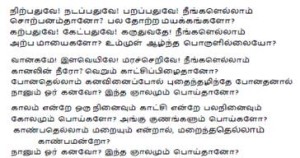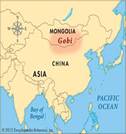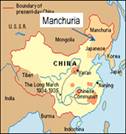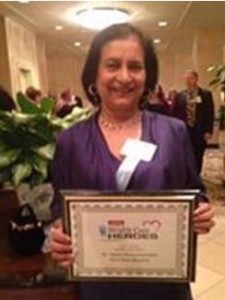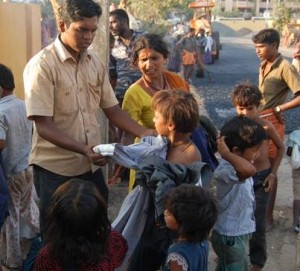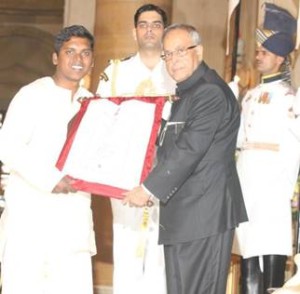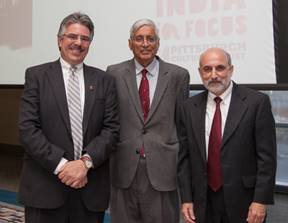Archive for category Past issues
Hindu Temples are Getting Americanized… …
 By K S Venkataraman
We go to great lengths to “Indianize†Hindu places of worship in the US by changing their exterior facades with Gopurams and Shikharams and interiors with Hindu murals and architectural features.
However, even as these places maintain a façade of “authenticity,†in reality they have taken a leaf out of the way churches are organized here. Like American Protestant churches, our temples 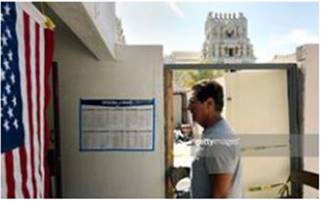 have bylaws, annual membership dues, elections, general body meetings, budget allocations, appointment of employees and priests — and scandals too.
have bylaws, annual membership dues, elections, general body meetings, budget allocations, appointment of employees and priests — and scandals too.
There is nothing new in this. Even animals, when they migrate, learn to adapt to their new ecosystem. That is their only way to survive. Otherwise, they become extinct. Even plants learn to adapt and evolve.
Many temples have also added Indian twists in this adaptation: providing de-facto quota system on the basis of linguistic groups for electing members and temple officers, appointing committees, hiring employees, priests, even cooks. Caste-based reservation is not there, at least not yet! Another feature the temples have most passionately embraced from American churches are fights and schisms spanning from the most trivial to mundane, to serious matters.
Coming from India, one feature that surprised me the most in my early days was the use of places of worship – churches – as polling stations. This is a taboo in India, given the religious strife among and between Hindus, Muslims, and Christians. But then, when I learned more about the early political history of this great nation, I realized that places of worship have always been places where people gathered to discuss politics and social issues, often with church leaders taking a stand on political, social and cultural issues.
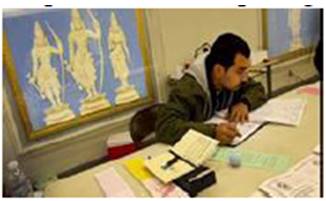 Finally, the Hindu temples in the US seem to be slowly taking a baby step internalizing this one good feature of American democracy. In the recent primary season in California, the Malibu Hindu temple opened its doors as a voting center. The pictures in this story are taken at the Malibu Temple in California, used as polling station in the recent primary.
Finally, the Hindu temples in the US seem to be slowly taking a baby step internalizing this one good feature of American democracy. In the recent primary season in California, the Malibu Hindu temple opened its doors as a voting center. The pictures in this story are taken at the Malibu Temple in California, used as polling station in the recent primary.
The Malibu Hindu Temple, though, is not the first one in setting this good example. The Hindu Samaj Temple in Duchess County in Upstate NY has been doing this for years. Hopefully, other “premier†institutions will follow this good example and become Americanized.  ♣     Â
Home                        Â
Making Authentic Tayir, Dahi, Mosaru, or Perugu
By Kollengode S Venkataraman
My long craving for the authentic home-made dahi (tayir in Tamil and Malayalam, mosaru in Kannada, and perugu in Telugu), recently got satisfied in a totally unexpected way.  Let me preface that this uniquely Indian and perfected home-made product — unique in its texture and taste — goes by the generic name yoghurt in the US.  As Dahi aficionados know only too well, this is only an approximation.
Many of our everyday eats are products of biochemical reactions. Breads — both the freshly baked “artisan†type and the run-of-the-mill types in grocery stores — are “leavened†due to fermentation of bacteria in yeast. Bakeries take great care in preserving the culture of the original strains of bacteria in their starter dough for tens of years so that the breads come out the same way year after year. What makes the French sourdough bread and the Italian bread unique, are the differences in the yeast-enriched starter dough, the flours used, and in the baking techniques. Wines, beers and antibiotics too are products of biochemistry.
The perfect dosas and idlis require that the batter you make by wet-grinding blends of well-soaked urad dal and boiled rice — please do not mistake boiled rice for cooked rice — is allowed to ferment for several hours. The batter acquires a sour taste and is full of gas bubbles (products of fermentation) which make the idlis soft; while making dosas, the batter spreads better on the skillet and the dosas come out with countless small holes when the tiny gas bubbles burst as if by magic design. Indian achars and the Korean kimchi are products of unaerobic fermentation. The Japanese natto, a breakfast item in parts of Japan, is fermented soya beans.
Back to good old authentic tayir that goes by the generic name yoghurt in the US. The desi dahi is very distinct — it has its own texture and taste — and is very different from its distant cousins, zabadi (Arabic), the giaoúrti (Greek) and yoghurt (Turkish). The best dahi I had outside my home is the Brijvasi-type in Delhi. Obviously, the best dahi you know is what your mom made in India.
After arriving in the US, I reconciled myself to the standardized salt-laden buttermilk in cartons and the plain Dannon yoghurt from grocery stores. The fine print on the Dannon container said it contains live acidophilus bacteria. So, I tried to make tayir with 4% milk using Dannon yoghurt as the starter. For those who know nothing about making tayir at home, all that you need to do is:
- Bring ~½ gallon of milk to boil and cool it to room temperature;
- Add approx. two or three tbsp of starter yoghurt to the milk, while gently stirring the milk with a spoon; and
- Let the blend stand overnight at temperatures ~75 F.
When I did this, however, what I got was not the tayir I was used to, but a gooey yoghurt that scooped like a thickened milkshake; worse still, it tasted terrible compared to the tayir I know. I wanted the tayir to handle well — I should be able to cut it into slices like pudding. I also wanted my tayir mellow, and naturally and very mildly sweet (without added sugar) and mildly tart and sour all at the same time, like the tayir my amma made. What I got was not anywhere close.
Having known enough about the effects of time, temperatures and concentration — a subject called chemical reaction kinetics — in my Chem. E. education, I tried all combinations of setting time, temperature and the quality of milk, (different blends of 2% and 4% milk). I ended up with the same gooey stuff, sometime even worse. I gave up, attributing my failure to the type of milk here. This was nearly 15 years ago.
Then recently I was talking to Janaki Raghupathi of Murrysville, shooting the breeze. I’ve known her for over 25 years. I casually told her about my reasoning on why we cannot make good tayir here.
She laughed. “Venkataraman, it has nothing to do with the milk, but everything to do with the starter tayir,†she was categorical. She continued, “Over 30 years ago, I brought with me a small bottle of tayir from my home in India. I used it as a starter material for making tayir at home. I got good tayir from the regular 2% or 4% milk. Every time I make a new batch, I set aside a small portion for the next batch. Why don’t you try with the starter tayir from me.â€
I made the tayir at home using her starter stuff using a blend of 4% and 2% milk. I boiled ½ gallon of the milk and cooled it to room temperature; then added 3 tbsp of Janaki’s starter tayir, gently mixing it into the milk by stirring with a ladle. I kept the mixed blend overnight in the oven chamber of our cooking range with the heat turned OFF. However, the 40-w light in the oven chamber was turned ON to keep the temperature around 75F. This is important during winter.
Next morning, when I stuck a teaspoon into the fermented product, I sliced into it much like the tayir I grew up with in Kerala. I knew right then that this was different. I was excited. With great expectation, I put the spoonful of the tayir into my mouth. Ahh! I was in heaven! I got the same taste of the desi dahi, very mildly sweet, at the same time mildly sour and tart as well — very close to the tayir my mom made decades ago.
So, if you want to make the dahi, tayir, or mosaru, or perugu that you grew up with in India, get some authentic starter material from friends. Follow their instructions to get it right and enjoy it with your family.
When you do this and get the authentic product, I have only one request. Call it by its authentic name, Dahi, Tayir, Perugu, or Mosaru. And never ever call it yoghurt or curd. Because it simply is not, and can never be — the same way French sourdough bread is not the same as the Italian bread.    ♣
Home
Points to Ponder: Muhammad Ali (January 17, 1942 – June 3, 2016)
Muhammad Ali On his opposition to the Vietnam War:
“Why should they ask me to put on a uniform and go ten thousand miles from home and drop bombs and bullets on brown people in Vietnam while so-called Negro people in Louisville are treated like dogs and denied simple human rights?
“No, I am not going ten thousand miles from home to help murder and burn another poor nation simply to continue the domination of white slave masters of the darker people the world over. This is the day when such evils must come to an end. I have been warned that to take such a stand would put my prestige in jeopardy and could cause me to lose millions of dollars which should accrue to me as the champion.
“But I have said it once and I will say it again. The real enemy of my people is right here. I will not disgrace my religion, my people or myself by becoming a tool to enslave those who are fighting for their own justice, freedom and equality…
“If I thought the war was going to bring freedom and equality to 22 million of my people, they wouldn’t have to draft me, I’d join tomorrow. But I either have to obey the laws of the land or the laws of Allah. I have nothing to lose by standing up for my beliefs. So I’ll go to jail. We’ve been in jail for four hundred years.â€
The Greatest’s Other Famous Quotes:
“What you are thinking is what you are becoming.â€
“The man who views the world at 50 the same as he did at 20 has wasted 30 years of his life.â€
“Float like a butterfly and sting like a bee.†  ♣
Home
Report Highlights the Need for a More Diverse Demographics in the Region
Posted by admin in April 2016 on April 10, 2016
By Kollengode S Venkataraman
e-mail: Â ThePatrika@aol.com
Do you know that the work force in southwestern Pennsylvania (Allegheny County, including the City of Pittsburgh and the six surrounding counties) is the least demographically diverse compared to many other benchmark metropolitan areas in the US? That is what Pittsburgh Today (www.pittsburghtoday.org), an initiative of the Regional Indicator Program (Mr. Douglas Heuck, Program Director) finds in its recent report. The initiative is hosted by the University of Pittsburgh’s Center for Social and Urban Research. Its mission is “Comparing our region to other areas of the country… [on] how we measure up, and what our strengths and weaknesses are…†They attempt to provide a statistical picture of the region “to stimulate a discussion of where we are and where we hope to go.â€
The second report, The Pittsburgh Regional Survey under the aegis of Vibrant Pittsburgh (www.vibrantpittsburgh.org) was released on January 13. Mr. Heuck presented the key findings. Vibrant Pittsburgh’s mission, with support from Pittsburgh-based business executives, elected officials, and charitable organizations, is to promote diversity in work places. Melanie Harrington, the CEO of Vibrant Pittsburgh, led the event releasing the survey.Recently they published two reports, 2015 Pittsburgh Today and Tomorrow and Pittsburgh Regional Survey (2016). These reports are available on line. A key finding in the first report is troubling and worth reproducing: “The share of jobs held by African Americans, Asian Americans, and Hispanic workers in southwestern Pennsylvania is so small that it ranks dead last among 15 regions benchmarked…â€
The presence of Allegheny County Chief Executive Rich Fitzgerald’s and Pittsburgh Mayor Bill Peduto at the event gave additional gravitas. Their participation on a wintry day, with single-digit temperatures and snow all around, highlighted how seriously these two key elected leaders of our region look at the lack of work-place diversity here.
In his opening remarks Fitzgerald acknowledged that our region is the least diverse metro area in the nation, and explained why addressing it is important to the city, county and the region. As Mayor Peduto said in his comments towards the end, Nashville, TN, Louisville, KY, and Cincinnati and Columbus in Ohio have more diverse demographics. The mayor poignantly pointed out that a few decades ago, the Duquesne Club, the exclusive meeting place for corporate executives in town, did not allow Jews to be members, and women were not allowed to be full members. We would not have grown to where we are today, he said, if we had not changed.
Fitzgerald identified two welcome trends in the 2015 Pittsburgh Today and Tomorrow report: young people growing up here prefer to stay here, and educated young people are moving into our region from outside with jobs. After all, Pittsburgh has been identified as one of the More Livable Cities with its excellent public and private schools for children, world-renowned universities, a top-notch healthcare system, nationally ranked sports teams, an excellent airport, museums, theaters, a world class symphony, ballet… … Still, many outsiders’ continue to associate coal and steel with our region, even though today steel and coal are only a very small part of our region’s economy.
If you wonder why workplace diversity is important, consider this: the demography of the US has been changing as shown in the chart below (Ref: The U.S. Foreign-Born Population: Trends and Selected Characteristics, by William A. Kandel, CRS Report for Congress, 2011 (http://fas.org/sgp/crs/misc/R41592.pdf)
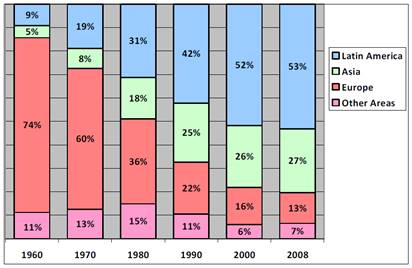
The % of Foreign-Born in the US since 1960.
We can project this trend into the future and see how the mix of US population will be in the decades ahead. The America our children and grandchildren will see will be very, very different demographically. This trend will irreversibly change every aspect of life in the US.
Besides, the population growth in our region between 2000 and 2010 is almost zero compared to, say Charlotte, NC (7% growth), Denver (8.8%), Columbus, OH (4.9%), Indianapolis, IN (4.4%), and Louisville, KY (2.8%). Generally, metro areas that are growing are also more diverse demographically.
In the globalized world today, a diverse population is necessary for our region’s vitality and growth. When US corporations and multinationals based in Europe and Asia want to open offices here, or want to move their headquarters here, one key factor for their evaluation is how demographically diverse the place is to make their current employees move here, or to hire new employees from outside.
Among the many questions the Pittsburgh Regional Survey (2016) asked its respondents were these:
How committed do you think your employer is
- i) to recruiting employees from racial and ethnic minority groups?
- ii) to promoting employees from racial and ethnic minority groups?
Do you agree that the Pittsburgh region welcomes racially/ethnically diverse people?
How racially and ethnically diverse is your workplace?
Do you agree there is value in having a diverse workforce?
The survey also asked this thoughtful question in their questionnaire: How often have you invited someone of another racial or ethnic background to your home?Â
With so many subgroups within the Indian Diaspora here, we need to ask ourselves: How often have you had some serious conversation in your home or in a restaurant with Indians of other linguistic and regional background? Sometimes one wonders whether we are living in our own echo chambers unwilling to learn from others outside our comfort zone.
Laws Changing the US Demographics
(Source: Abraham Mosisa, an economist in the Division of Labor Force Statistics, Bureau of Labor Statistics, in the Monthly Labor Review, May 2002 and http://www.bls.gov/opub/mlr/2002/05/art1full.pdf).
In the 18th and 19th centuries (the early days of the Republic), immigrants reached the Eastern Seaboard mostly from Northern Europe (England, Germany, France) and Africa (slave trade). In the 19th century, Irish immigrants came in large numbers to escape the famous Potato Famine.
Simultaneously, starting in the mid-19th century, Chinese contract labors were brought to the West Coast to work in the gold mine and also to lay the Transcontinental Railroad. You can see in Hollywood Westerns Chinese immigrants barely speaking English operating the laundromats, and sweating it out laying the railroads. The influx of Chinese laborers was stopped by the Chinese Exclusion Act in 1882.
Starting from the 1900s new immigrants from Europe came increasingly from Southern and Eastern Europe (the Italians, the Greeks, the Poles, the Slavs …), mostly Catholic, poorly educated, and with little familiarity with English, both in terms of language and culture.
The Immigration Act of 1917 restricted European immigration and the 1921 Emergency Quota Act applied immigration quota on the basis of nationality and the country of origin. This quota-based act was reaffirmed in the Immigration and Nationality Act of 1952, which remained in force with minor changes till 1965.
The Immigration and Nationality Act of 1965 is a great bench mark in US history. It did away with quota-based immigration that took into account race, national origin, and ancestry. Between 1960 and 2000, the proportion of the foreign-born population that had come from Europe dropped from 74.5 percent to 15.3 percent, while the proportion coming from Latin America increased from 9.3 percent to 51 percent.â€Â See the chart on Page 4. The Nationality Act of 1965 is the reason most Indian-Americans are here as immigrants, naturalized and natural citizens. By country-of-birth in the population among the foreign-born, Europe is way below. Basis: 2010 Census. See the plot below.
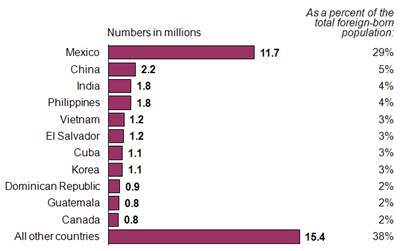
Population of Foreign-Born in the US (US Census 2010 data)
            ♦♦♦♦
An Unusual Opportunity to Help to Girls’ Education Among the Working Poor in India
Posted by admin in April 2016 on April 10, 2016
By Nandini Mandal, Nandanik Dance School
e-mail: nandini@nandanik.com Â
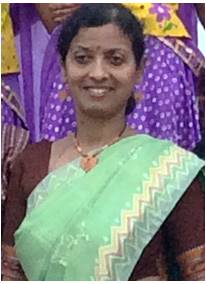 Santosh Gurlahosur, a young IT professional, approached me last summer with a request: “Ma’am, would you be able to choreograph for a music video emphasizing the importation of sanitation in village schools — especially for the girl child?â€
Santosh Gurlahosur, a young IT professional, approached me last summer with a request: “Ma’am, would you be able to choreograph for a music video emphasizing the importation of sanitation in village schools — especially for the girl child?â€
Knowing that one of the main reasons for high dropout rates of post-puberty girls in schools in rural India is the lack of sanitation, I instantly said, “Of course, I would love to.†Santosh smiled a hesitantly, “Really Ma’am? Thank you, no one was convinced when I approached others.â€
He was planning to shoot a video presentation with other footage with a song along with a public message for use in India or elsewhere. After the initial planning, we—our dance school working with Teen Taal, Inc. —opted for an outdoor shoot. What else could be a better place than the Point, Pittsburgh’s very own Triveni Sangam?
It was a warm sunny July morning when dancers of our Nandanik Dance Troupe arrived at Point State Park. As we danced at different
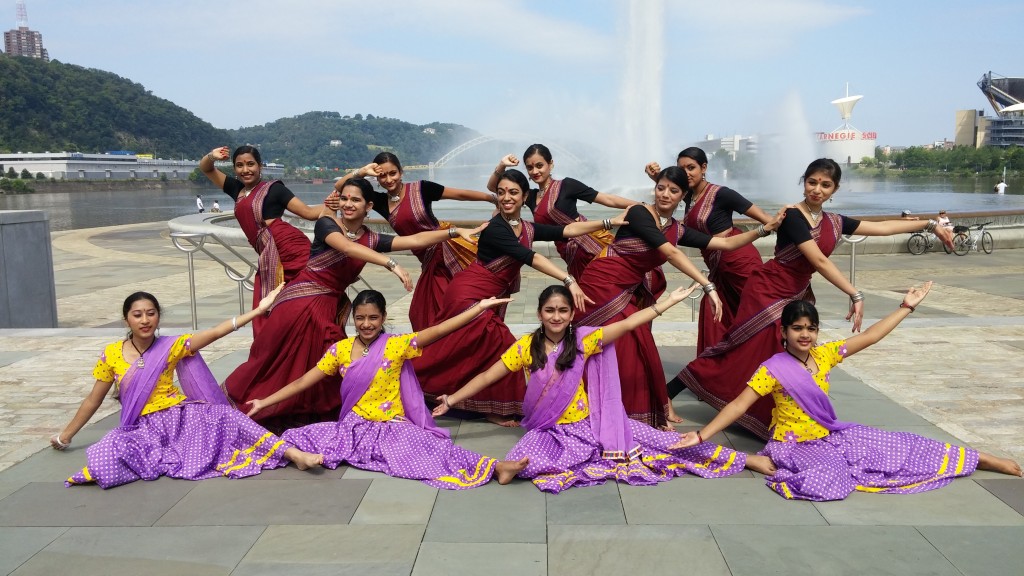
L to R — Front row : Mythri Sundar, Antara Cleetus, Ashwini Walavalkar, and Janhavi Gan-gisetti. Second row: Kumudini Venkata, Jahnavee Mittal, Sana Mitra, and Sai Bhatte. Third row: Keerthana Lanka, Manasi Jadhav, Roosha Mandal, and Madhumita Mahes.
spots at the Point, the sun soared higher, the mercury climbing to the 90s by 11:00 a.m. It became increasingly challenging for the dancers to look at the camera, or keep dancing without taking frequent breaks for drinking water. But they never complained. Our audience — they were bystanders, bikers, tourists, joggers, and people from all walks of life – were enthralled. They all had come to the fountain to enjoy a summer morning when they saw the girls taking their positions. They stopped and cheered after the dance was over. Many came up to ask what it was all about.
The lyrics by Santosh portray the regret of a girl child in India who is not able to go to school because of the lack of basic facilities such as toilets. The girl loves to study and wants to play with her friends in the school, but she is not able to do so. This song is sung by Indian Idol winner Anjana Padmanabhan and composed by an upcoming music director in India Nobin Paul of Bengaluru. The video was filmed by David Bernabo, a very talented film maker and artist from Pittsburgh.
The song also brings up a more serious question: When so much construction is going on all around India, why are toilets for girls in schools for the working poor not a priority?
The girls in my dance school felt very strongly about this and were happy to contribute to this noble endeavor through their dance. Many of them have seen the difficulties traveling in India because of the lack of sanitation facilities for women.
I was very touched by Santosh Gurlahosur, the motivated young man, and his young group of volunteers who are trying quietly and selflessly to help in the cause of girls’ education in rural India.  ♦
Exhibition on Poems and Paintings
Posted by admin in April 2016 on April 10, 2016
By Premlata VenkataramanÂ
e-mail: Â ThePatrika@aol.comÂ
We have seen paintings inspired by mythology and history: Da Vinci’s Last Supper, John Trumbull’s Declaration of Independence  and Raja Ravi Varma’s paintings on events from Ramayana and Mahabharata, and Gandhi’s Salt March to Dandi. And add to that the famous Geetopadesham scene by countless artists.
In this tradition, the Post-Gazette inaugurated Verse Envisioned, an art exhibition at the Panza Gallery in Millvale featuring over twenty paintings inspired by the works of contemporary Pittsburgh-based poets. The cornucopia of poems spanned a wide range of themes.
On Saturday, January 16, the inaugural day of the exhibition, artists of Pittsburgh and their patrons were in full attendance, notwithstanding the cold, wintry day. The exhibition ran from January 16 to February 27. Seeing the two art forms side by side complementing and enhancing each other, was a unique experience.

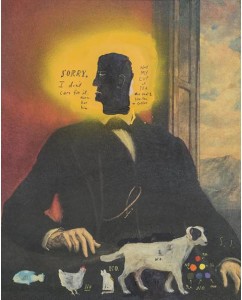 The exhibition was made a reality under the leadership of Greg Victor, the Op-Ed editor of the Post-Gazette, and Rachel Klipa, an independent curator and the Manager of Community Engagement at the Office of Public Art in Pittsburgh.
The exhibition was made a reality under the leadership of Greg Victor, the Op-Ed editor of the Post-Gazette, and Rachel Klipa, an independent curator and the Manager of Community Engagement at the Office of Public Art in Pittsburgh.
Welcoming the large crowd at the exhibition, Greg Victor credited Sam Hazo, Poet Laureate of Pennsylvania, who, in 1993 suggested to the Post-Gazette editors to include poetry as a feature in the newspaper. It is now featured on Saturdays. If we did not know the background, it would have been difficult to say whether the poem inspired the painting or the other way around.
Maya Weiss, one of the featured poets, read her poem titled The Man Who Didn’t Like Anything. She is a 10th grader at Shadyside Academy. It was a humorous and somewhat cynical poem juxtaposed with a painting by Stacy Innerst.  See above.
David Joseph Kutcher’s Civics was an emotional and poignant poem in which the poet recollects the supreme sacrifice of his father in WW II as the reason he goes to vote in every election. Alan Byrne’s painting showed a man in front of the voting machine with a group of soldiers (his forebears) behind him looking on. See below:
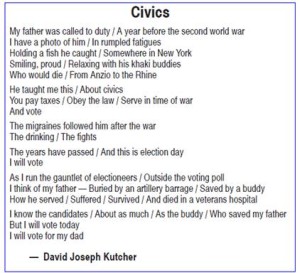
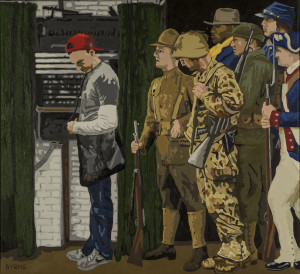
Lori Jakiela’s poem on aging and dying, replayed between a woman with her aged father and her young daughter, echoed a sentiment that many of the sandwich generation are feeling.
Bringing together two very different art forms and harmonizing the themes require lots of creativity from everyone involved. So making the exhibition a reality was a treat to lovers of poetry and painting during a chilly day in January in Pittsburgh.
We thank the efforts of the editorial staff at the Post-Gazette, and the poets, painters, curators and gallery  owners for making this happen.
The book containing the paintings and the poems featured in the Post- Gazette is available online at www.store.post-gazette.com.
Note: We thank Mr. Mark Panza of the Panza Gallery in Millvale where the exhibition was held for all the pictures in this story.  ♦
Obituary:Â Dr. Indravadhan Pandit (1937- January 20, 2016)
Posted by admin in April 2016 on April 10, 2016
Dr. Indravadhan Pandit, a long-time resident of our area and a cardiologist, passed away on Wednesday, January 20, 2016. The cause of his death was complications from pancreatic cancer for which there is no cure.
 Dr. Pandit grew up in Visnagar, Mehsana district, in the northeast part of Gujarat. Earning his medical degree (MBBS) from the Baroda Medical College in 1966, he came to the United States with his wife Devyani, also a physician. After short stays in Detroit, Boston and Cleveland, he made Pittsburgh his permanent home, starting his medical practice.
Dr. Pandit grew up in Visnagar, Mehsana district, in the northeast part of Gujarat. Earning his medical degree (MBBS) from the Baroda Medical College in 1966, he came to the United States with his wife Devyani, also a physician. After short stays in Detroit, Boston and Cleveland, he made Pittsburgh his permanent home, starting his medical practice.
He was an interventional cardiologist for over three decades at UPMC Shadyside Hospital and its director of the catheterization laboratory for several years. He was a fellow of the American College of Cardiology and a member of the American Medical Association. He was also with the Pennsylvania Medical Society, where he was active in establishing need-based scholarships for medical students.
As a philanthropist, Dr. Pandit lived and breathed working for charities. As chairman of the AAPI (American Association of Physicians of Indian Origin) Foundation, he put his heart and soul into visiting clinics from Punjab to Tamil Nadu serving thousands of poor patients at no or minimal cost. He passionately raised funds in Pittsburgh for almost twenty years for this cause. In 2002, the AAPI honored Dr. Pandit with its Most Outstanding and Dedicated Service Award.
Dr. Pandit’s interest went beyond his professional activities. He was a pillar of the Indian community in our area. He was a founding member of the Hindu Jain Temple, where he served as Chairman of the Board of Trustees, and also its Endowment Fund. Dr. Pandit, working closely with other volunteers at the temple, raised large sums of money for the maintenance and restoration of the temple. The temple honored him and his wife Dr. Devyani with a Lifetime Service Award.
Dr. Pandit was a member of TAPI (Tri State Association of Physicians of Indian Origin), the treasurer of the US-India Forum, and the secretary-treasurer of the Encyclopedia of Hinduism. If there was an India cause in town, he was engaged in it. He was actively involved with the Indian Nationality Room project in the Cathedral of Learning at Pitt. He was also a benefactor of the Carnegie Museums and many other charities. Even in his retirement, he volunteered at a food packing facility near Kennywood that delivered food to the homeless.
He was a voracious reader of Indian literature and eastern and western philosophies. His other pastimes were golf, tennis, music and dance.
A principled man, Dr. Pandit would not compromise with anyone for the right cause. I was once sharing a room with Indravadhan at the AAPI Governing Body gathering. Seeing that I was active in a political action committee, he told me, “Krishan, if you want to work in a charitable foundation, it is pure like Ganga in Rishikesh, serving the poor and needy; otherwise politics is dirty water.†I could not agree with him more.
His friend Jitu Desai recalls, “Indravadhan was a giving and forgiving man. Anyone asked him for charity, he always responded generously.â€
He endured the treatment (including chemotherapy) for pancreatic cancer with great stoicism and grit. When we went to see him, he was positive, witty and ready to fight till the very end.
He leaves behind Devyani, his life partner of 40-plus years; his two daughters,Amy and Neha; five grandkids, Anand, Asher, Ariya, Maneklal and Maria; his sons-in-law, Ashis Tayal and Daniel Gerhardy; and a number of friends in the medical fraternity and the Indian community.
Dr. Pandit’s funeral services were held at the Beinhauer Funeral Home with his son-in-law Ashis Tayal performing the Hindu cremation rites led by Pandits Shri Suresh Chandra Joshi and Shri Vinod Pandey of the Hindu Jain Temple.  — By Krishan Aggarwal, Coraopolis, PA   ♦
Bhartrhari’s Nine Fears of Mankind
Posted by admin in April 2016 on April 10, 2016
By K S Venkataraman (e-mail: ThePatrika@aol.com) and
Arun Jatkar (e-mail: AJMarathi@yahoo.com)
Bhartrhari is a celebrated Sanskrit poet of India belonging to the 5th century during the Gupta’s period. He is the author of the famous Tri-Satakam (literally, The Three-Hundreds), on three topics ─ Vairaagyam (Dispassion), Neeti (Good Conduct), and Shrngaaram (Sensuality) ─ with one hundred verses on each. Decades ago, when we read his sensuous verses on Shrngaaram, we wondered how Bhartrhari could also write profoundly on Vairaagyam (Dispassion). We found that Bhartrhari is not unique here. TiruvaLLuvar (वळà¥à¤³à¥à¤µà¤°à¥ not वलà¥à¤²à¥à¤µà¤°à¥), the author of the famous 2000-year old Tamil literary work called TirukkuraL with 1330 couplets, wrote along similar lines. For most mortals, the transition from Sensuality to Dispassion is a natural and healthy one, coming from one’s mental maturity and also because of age-related drop in testosterone in men and estrogen in women.
In any case, here is one verse by Bhartrhari from the Vairaagya Satakam on the nine fears of mankind, first in the Devanagari script, and then in a non-literary, but factual translation:
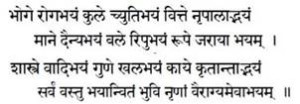
In gratification of sensual pleasures, the fear of ailments;
In noble pedigree, the fear of disgrace; Â In wealth, the fear of kings;
In status, the fear of hardship; Â In strength, the fear of enemies;
In beauty, the fear of decay; Â In scholarship, the fear of challengers;
In virtues, the fear of slander; Â Â In the body, the fear of death.
In this world, everything for mankind is filled with fear.Â
Dispassion alone gives freedom from fear.
On first reading, the verse is straightforward and rather mundane. However, on many levels, the messages conveyed are profound for their timelessness, given that the verse is 1500 years old.
On Indulgence: The Sanskrit word bhoga means sensual gratification that needs to be understood in many contexts. There is no need to expand on the most common sensual pleasure. There are other types of sensual gratification. The common one is gluttony — overindulgence in the calorie-packed and unhealthy food and drinks. Even modern medicine emphasizes moderation in these, something Asian cultures have insisted through the millennia. Observing Bhartrhari start his verse with sensual gratifications, we can infer that people overindulged even in his time.
Fear of Kings: It is interesting that in the case of wealth, Bhartrhari talks about the fear of kings, and not thieves and robbers. Today, with elected governments replacing kings of yesteryear, landowners are afraid of land ceilings and ownership through legislation; business people are afraid of governments nationalizing industries and bringing in foreign and domestic competition. Even when these laws are enacted for public good, land and business owners always cry foul for getting a better deal out of the government.
And people with wealth are perpetually anxious of changes in tax and inheritance/estate laws to protect their wealth. This fear is what is forcing them to stash their money — hard-earned or not, well-gotten or ill-gotten — in secret off-shore banks.
Fear of Falling from Grace: This fear is universal. Today we see people from blue-blooded or rich families, religious leaders, celebrities, politicians and others, get arrested for sexual misconduct and financial irregularities. In the US, even prestigious Catholic dioceses carry liability insurance out of fear of lawsuits against errant priests’ misconduct. Several dioceces in the US also filed for financial bankruptcy after losing their moral edge, in the wake of lawsuits involving wide spread pedophilia indulged by Catholic priests that was covered up by church leadership not only in local churches, but also by the bishops of dioceses, prelates, going all the way up to to the Pope in the Vatican.
Fear of Enemies: No kingdom remains strong forever. Towards the end of Mahabharata, Arjuna, the most celebrated warrior, finds himself helpless against the tribesmen who attack and rob the ornaments of the women he was escorting to safety from Dwaraka to Hastinapuram. The mighty Roman Empire collapsed under the brute force of the Barbarians from Northern Europe. Between the 8th and 12th centuries, the mighty Hindu kingdoms of Northern India succumbed to the invading Arab, Turkish and Afghani armies. The Ottoman Empire collapsed at the end of the First World War. The tiny island nation of England spread its reign over five continents and finally shrank back to its original confines. After the Second World War, it seemed like the U.S. would forever remain an unrivalled military power in the world because of the nuclear weapons. But that dream shattered several years afterwards.
So the strong nations of today, the US, France, Germany, Russia, China, and England, spend billions year after year to upgrade their armies and weapon systems out of their fear of enemies, both real and perceived. Even in poorer countries defense budgets gobble up a large portion of the national budget, while their citizens don’t have access to half-decent education and healthcare. The fear of enemies is not confined to military might alone. Economic and technological threat among nations is also real.
Fear of Decay Due to Aging: No one remains handsome or beautiful forever. Time takes its toll wreaking havoc on one’s health and beauty. In earlier days people accepted this as natural. However, advances in science have given hope that beauty can be preserved for a longer span of time. Among women, the fear of fading beauty with aging has spawned a whole new industry — Cosmetic and Reconstructive Surgery — originally developed to treat burn victims and people with severe deformities. In 2014 in the US, 92% of all elective cosmetic procedures were performed on women: One million cosmetic procedures on women under 30 years of age and a whopping 13.8 million on women over 30. (Source: www.plastic surgery.org). Today, the original intent of plastic surgery may account for less than 5% of plastic surgeons’ lucrative business.
Fear of Competition: We all understand the insecurity that professionals, college professors (including tenured ones), lawyers, doctors, artistes, and engineers feel from colleagues perceived to be better than themselves; or when newer technologies make their skills useless. While they profess that competition is good for society at large, as individual professionals they are not philosophical when they see competition threatening their own survival, or demolishing their theories or defunding their pet projects.
In today’s consumer world progress is seen as synonymous with higher per-capita consumption of every commodity. So, people caught in the whirlpool of trying to get ahead of others in the comparative lifestyle today may not agree with Bhartrhari’s advice that Vairaagyam (dispassion) is the antidote for fear. But people standing out of the vortex of consumerism are beginning to say, “Enough.â€
In any case, even those who disagree with Bhartrhari’s antidote to fear will agree that his Nine Fears of Man are as valid today as they were 1500 years ago when he wrote the verse. These fears are still the driving forces controlling not only our individual behavior, but also our collective behavior as societies, corporations and nations.  ♦
On the Association of “British†Scholars
Posted by admin in April 2016 on April 10, 2016
By Kollengode S Venkataraman
E-mail: Â ThePatrika@aol.com
I was watching a YouTube video. The New Age Guru Deepak Chopra was talking in his deep, resonant voice about mind-body nexus, a topic now mainstream in modern medicine. The banner behind in loud colors read Association of British Scholars, New Delhi. I was intrigued by the name of the organization. Then I e-mailed several of my cerebral friends — researchers, physicians, university professors, linguists, and eclectic people with good tastes in music, art, literature — with this request:
“If you find an organization that goes by the name Association of British Scholars, India, what would be your understanding of the organizers and members of that group? Will you please give me your answers in two or three sentences? I assure you that I will keep your response private.â€Â
I only said my friends are cerebral. That does not imply that I am. Here are their responses in the following paragraphs. I am reproducing them verbatim, except in one case, where I have truncated it to save space. Since I assured them I would keep their responses private, I only give the initials of the respondents as my own memory aid so that I know who they are. Here I go:
JK: My initial take on this would be that it represents a group of British scholars who live in India. Or, on second thought, that they are Indians in India who have made Britain the focus of their scholarly endeavors.
SS: To me, it would suggest an India-based chapter of a worldwide group of scholars of British origin.
JL:Â This is a group of historians who have specialized in the field of British Empire and British Raj in India. They are based in India and may include Indians and remnants of the rulers who stayed on in India. Modesty is not their virtue; otherwise the name of the Association would have been Study Group of British Empire and British Raj, India.
BD:Â Looks like a scam.
SS: My first reaction will be that this organization is a group of British “Scholars” who are interested in defending the Raj Period of Indian History. Personally, I would like to hear them and what they stand for.
AJ: On the face of it, a name like “Association of British Scholars, India” would mean to me that it is an organization of scholarly people of British origin, who are residing in India. But, when you look closer, it is odd: 1) A group of true scholars will not call itself “Scholars.”  They may call themselves “Indologists,” “Historians,” “Mathematicians,” “Engineers,” “Physicians,” “Writers,” etc., but wlll shun the epithet “Scholars.â€Â 2) We are led to believe that the British are unlikely to be self-promoters†— don’t know how true it really is. I wonder if this could be a group of Indians who have no humility at all and have never heard or read that humility is the true ornament of knowledge and wisdom, calling themselves “British Scholars.â€Â One is tempted to ask, “British scholars of what branch of intellectual inquiry?â€
PV: My understanding of this is that it is a bunch of scholars from Britain who are based in India. Since the Association is of British Scholars, the comma denotes the further clarification on their location.
HS:Â I can only take a guess. I assume you have talked to Jxxx Myyy, Assistant Professor, History Department at XXX YYY Univ.
SC:Â I would assume that it comprises of Indian people who have had higher education in Britain and are currently residing in India.
RS: It sounds like a group of Brits in India who call themselves scholars.
Now, ABS (Association of British Scholars) is in India with over 24 branches, including Vishakhapatnam, AP, Bhubaneshwar, Odisha, and Tiruvanantapuram, Kerala. The Association was founded/established/organized by the British Council in India, an important wing of the British embassy in India. According to their website, “The Association of British Scholars (ABS) is a national forum to facilitate the networking of Indians who have studied or trained in the UK. ABS India aims to strengthen the Indo-UK relationship by harnessing the resources, expertise and potential of every ABS chapter through networking, sharing information and hosting social, cultural and intellectual activities.â€
If you go by their website application form, a certificate course, or a short-term course in any field such as law, engineering, or fashion design in a UK institute makes you eligible for seeking membership.
So, guys and gals, the members of The Association of British Scholars in India are your everyday brown desis, wanting to believe that they are “British†scholars. Their claim to their “Britishness†is a 4 or 2 year stay somewhere in the UK pursuing their graduate or undergraduate degrees in law engineering; or a 3-month certificate course 18th century Mughal history; or how Lord Macaulay consolidated India for the British King by creating millions of English-knowing clerks and his contribution to India reaching its greatness in the 21st century; or a certificate course on how the British invented Curry during their colonial days and brought it onto the world culinary scene, thus giving the pedestrian curry its due.
In a way, I cannot fault these brown “British†scholars. I pity them. For, these brown “British†scholars will be the butt of biting jokes if they call themselves “British†scholars anywhere in the UK or outside India.
India obtained its nominal political freedom in 1947. It is supposed to have become a republic 65 years ago, making a complete break from Britain. But Indians’ spiritual slavery to the High-Tea Gora Land is alive and well: The Indian embassy in London is still called the Indian High Commission, and the Indian ambassador is called the High Commissioner. In the British Empire High Commissioners were envoys of the Imperial Government to manage its “protectorates†not fully under the empire. In London, the Indian embassy building itself is called the India House.
Consider this also: Sixty-five years after becoming a Republic, the IDs for planes registered in India — the numbers towards the end of their fuselage — starts with VT, VT standing for Vice-regal Territories, another holdover from colonial days. Just look at the way the Brown sahebs in upscale India try to imitate the Ox-Bridge accent — con-TRAU-versy is just an example — trying to put others in their place.
There is a saying in Tamil: If you think that you are humble, you are not. So, if you call yourself a “scholar,†you certainly are not one. As AJ said in his feedback quoted above, “A group of true scholars will not call itself ‘Scholars.’ They may call themselves ‘Indologists,’ ‘Historians,’ ‘Mathematicians,’ ‘Engineers,’  ‘Physicians,’ ‘Writers,’ etc. etc., but wlll shun the epithet ‘Scholars.’â€Â Now, that is a scholarly comment by a rooted desi.  ♦
On Tea
Posted by admin in April 2016 on April 10, 2016
By Premlata Venkataraman
e-mail: Â ThePittsburghPatrika@aol.com
Premlata works in the technical services library of a well-known university in Oakland, and has cataloged many books dealing with Fluid Mechanics.
Tea, geopolitics, revolutions and upheavals seem to go hand-in-hand. Consider this: when the East India Company started trading tea and spices, the English got addicted to tea and ended up colonizing India! There is another theory making the rounds among British-Indians in the UK on how the British colonized India: they were running away from their terrible food, willing to go anywhere.
Wherever they went, the food they ate was better, far, far better. Their guns and cannons also helped.
North Americans, seeking independence from the British, dumped all their tea into the Atlantic Ocean, only to get addicted to coffee growing abundantly closer home. After declaring independence from the British, Americans almost dumped the English language as well, opting for German to be the lingua franca of the new nation. The resolution was defeated by one vote. Otherwise, we would be another Deutschland! Or at least, a Deutsch-speaking fremdes Land (“foreign land†in German)! Details here: http://www.watzmann.net/scg/german-by-one-vote.html.That’s the origin of the very American expression “every vote counts.â€
The origins of Tea is the Chinese T’e, the word for the plant Camellia sinensis for the tea leaves. In Mandarin, the word was ch’a, and later became the Indian chai. Green and black teas are made from the same plant. Green tea has higher levels of anti-oxidants, because the tea leaves are simply steam-dried and not fermented like the black teas.
Initially tea became popular in Buddhist monasteries, because small amounts of caffeine in teas kept the monks awake during long hours of meditation. For this reason, many monasteries cultivated vast tea fields. The Book of Tea written over 1000 years ago gives a detailed account of the cultivation and preparation of tea, the best types of water for brewing, and different classifications of tea.
Of course, there are as many ways to drink tea as there are different strains of tea. The Japanese developed it into a highly artistic ceremony, almost a spiritual experience that embodies harmony, respect, purity and tranquility, and also a lot of mystique. People take classes to learn the perfect way to conduct the Japanese tea ceremony, like people trying to become wine snobs! But ordinary Japanese sneer at this snobbery!
In India too tea is immensely popular especially when infused with spices and milk as a special drink for every occasion. Ginger-infused tea called masala chai was taken at the end of the meal as a digestive. Sweetened cardamom tea is popular as a restorative. But the Chinese look at the Indian sweet teas with disgust.
Tea shops all over Asia promote socializing, vigorous conversation, and debate; they were often the stage for discussing political intrigues, even cultural upheaval. Just imagine the samovar, tea and its imagery to the Russian revolution. In China, tea shops were hotbeds for discussing intrigues, new political ideas and communist ideology during the Cultural Revolution. Not surprisingly, in Kolkata, where Marxists held sway decades after their ideology died even in the Maoist China, tea shops were, and continue to be, the centers of literary and social movements. If you listen to them often, you’d believe that India is on the brink of an upheaval.
To this day the ubiquitous street corner tea shops in India dole out tea, cigarettes and paan (betel leaves with accoutrements), and sometimes also mind-altering herbs. Here changing political scenes, corruption, cultural and social attitudes are hotly debated. This is where the heart of India pulsates. These popular venues for taking the pulse of the nation, particularly during elections, are more reliable than exit polls.
It is not surprising that the current Indian prime minister was once a tea-vendor (a chai-wallah). His critics, discrediting him for his background, were stumped when he sailed into parliament with an absolute majority two years ago. One reason why the Indian brown-saheb anglicized elite does not like him is because he doesn’t belong to their social class!
So the next time you sip your tea with your buddies discussing politics and cussing politicians, remember, you carry the potential to change the world.  ♦
The Joy of Giving: The More You Give of Yourself, the More You Find Yourself
Posted by admin in April 2016 on April 10, 2016
By Darshan Goswami
e-mail: dlgoswami@hotmail.com
Darshan Goswami, a long-time resident here has more than 40 years of experience in the energy field. He worked as a Project Manager for Renewable Energy, Micro-grid and Smart Grid projects at the United States Department of Energy (DOE) in Pittsburgh. He supports the India Foundation for Children Education and Care, Inc. (www.ifcare.org).
We all know how great it feels to receive gifts. However, the joy of getting is short-lived. Our lives are richer when we share, and that great inner joy comes from helping others to better their lives. Truly giving from the heart fills your life with joy and nourishes your soul. Giving provides an intrinsic reward that’s far more valuable than the gift. As Mahatma Gandhi said, “To find yourself, lose yourself in the service of others.†True joy lies in the act of giving without any expectation.
Why Give? When people are asked why they give, the readiest answers include: God wants me to; I feel better about myself; others need, and I have; I want to share; it’s only right.
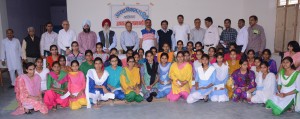
A group picture of all the girls in the school receivng support from IFCARE taken on the annual day function of the NGO. The adults standing in the back are the board members of IFCARE and some of the parents of the girls in the school.
The question I would ask is how did you feel? I imagine you felt very pleased with yourself and happy inside. Giving provides an opportunity to look beyond our own world and see the bigger picture. Your worries and challenges may not seem as significant when compared to other people’s situations.
The act of giving kindles self-esteem and brings happiness. After several years of soul searching, I discovered that my unhappiness was due to my want for things to fill the void of loneliness. During this inward journey, I also discovered “The Purpose of Living.â€Â Yes, I believe that giving makes you happier. But don’t take my word for it—try it out for yourself.
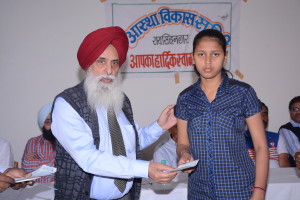
Dr. Gurmeet Singh, MD, President of Astha Vikas Samiti in Rajasthan, an NGO supported by IFCARE is handing over a chcke to Kum. Anjali Sain, a student in the local school.
The Power of Giving: Giving is one of the best investments you can make towards achieving genuine happiness. True giving comes from the heart, with no expectation of reciprocation. You’ll find that the more you give, the more you’ll receive. The power of giving is manifested in the kindness and generosity that you bestow on someone else. When you give unselfishly, the vibrational energy emitting from your subconscious is at its strongest. A famous American author, Ken Blanchard, declared “The more I give away, the more comes back.â€
It’s the joy and love that we extend to others that brings true happiness or union with God. We know that if people give just a little more—of their time, skills, knowledge, wisdom, compassion, wealth and love—the world would be a more peaceful and healthier place.
The rewards of giving are priceless. If you want to have happiness, you need to give happiness. If you want love, you need to give love. It is only in giving that you receive. No matter what your circumstances in life, you have the ability to give. The gift of joy will come to you when you give of yourself to others. Try it! Â It works!
Please join me in supporting the India Foundation (IF) for Children Education and Care (www.ifcare.org) to eliminate poverty in India through the education of underprivileged poor children and to empower poor women. Our Foundation awarded scholarships to 66 underprivileged poor children in Rajasthan, India on November 7, 2015 under its “SPONSOR A CHILD PROGRAM.†The sponsorship provides a needy child life’s essentials: school tuition, uniforms, books, school supplies, etc. for one year (100% of the donations go to the cause and are tax deductible in USA).
We are truly blessed and honored to serve humanity and poor children through our Foundation. We are truly grateful for compassion, kindness, and generosity of our sponsors to make a difference in the life of underprivileged poor children in India.
For further information, contact Darshan Goswami, 412-276-0544; dlgoswami@hotmail.com or Harbans Singh, 301-340-0836; or go to our website: (www.ifcare.org).  ♦
Rajyasree Ghosh’s Mesmerizing Vocal Recital
Posted by admin in January 2016 on December 28, 2015
By Seema Chaubey, North Huntingdon, PA
e-mail: seemachaubey@hotmail.com
The last of the Chhandayan house concerts of 2015 held on Saturday, October 31, at the Sahas’ home in Irwin, PA, presented Smt. Rajyasree Ghosh from Kolkata, accompanied on the tabla by Pt. Samir Chatterjee, the founder of Chhandayan. Pt. Chatterjee has been teaching tabla in universities for over thirty-five years and is well known in his field. Ayon Rivu Sinha of Pittsburgh was on the harmonium. The recital provided a wonderful blend of pure Hindustani classical music and Thumri, Dadra, Kajree, bhajans and Tappa.
Rajyasree is on the faculty of music at the Rabindra Bharati University, Kolkata, in India. She trained under four legendary gurus — Pt. Amiya Ranjan Bandopadhyaya of the Vishnupur Ghrana, Padma Bhushan Girija Devi of Varanasi, Pt. Arun Bhaduri of Sangeet Research, and Pt. K.G. Ginde of Belgaum. The unique signatures of the different gharanas were reflected in Rajyashri’s recital.
Rajyasree started most aptly with an early evening raga Shyam Kalyan. Her melodious and sonorous voice instantaneously captured the mood of the raga with its haunting interplay of both the suddha and tivra Madhyam and its emphasis on Re in the vilambit segment of the raga. The words of the song balama rasiya bhara lingered, resonating in our ears even when she transitioned into drut teen taal. Perfection is the way to describe the rendition of this raga in her strong and melodious voice with her control of bols, taal and sur. Next Rajyasree presented a drut segment of the raga Narayani, a bandesh in teen taal composed by S. N. Ratanjankar of Agra Gharana.
After a brief intermission, she transitioned into semi-classical music and presented three Thumris, which were illustrative of varied gharanas, taals, tempo and ragas. Kajri, a genre of semi-classical music popular in northeast India, often expressing romantic love, is sung during monsoon; Barse karire baderia mor chunariya bhije jai was lively and simple in its style and yet exquisitely spiced with subtle sargams in between.
There were more Thumris of the popular Benaras gharana such as nanadiya kahe mare mon based in Desh and Na jayo piya pardesh in Shivaranjani.
Tappa, a form of semi-classical vocal music coming from the rural Punjab, became popular in Bengal and in the royal courts. It consists of a rolling pace based on fast and subtle constructions, and the mood is laden with the emotions of a lover. Rajyasree presented both slow and fast paced Tappa compositions in Hindi and Bengali. Emotions of devotion and romance were subtly expressed in Radha and Krishna’s divine play in the song Rai anga sajabo diye ki bhushan. Her knowledge and skill in the genre was reflected in the various forms of the genre presented, such as Nidhu Babu’s Bengali tappa, Rabindranath Tagore’s Tappa, and a Hindi version of Miya me janewale.
Rajyasree ended her debut with a Dadra style devotional song and a shyama sangeet in praise of Mother Kali. Tabla support by the maestro Pt. Samir Chatterjee, as always, was outstanding. The duo created an atmosphere of lingering harmony as the notes and rhythm blended into unison.
As is usual, there was a delectable potluck dinner at the end of the recital in an informal setting during which those present interacted with the artistes of the evening.
Subramania Bharati on the Illusions and Transience of Life
Posted by admin in January 2016 on December 28, 2015
By Kollengode S Venkataraman
Subramania Bharati, (1882 –1921), simply called Bharatiyaar out of love and reverence by the Tamils, is the bench mark in Tamil literature, particularly in poetry. His impact is so profound that Tamil poetry today is seen as Pre-Bharati and Post-Bharati.
His full name is Chinnaswamy Subramania Aiyar. Bharati, meaning “one endowed with the blessings of Saraswati, the Goddess of Knowledge†is the title he received for his poetical skills when he was barely eleven.
His was a multifaceted personality. He was a freedom fighter, poet, essayist, journalist, social reformer, linguist… He spoke passionately on the emancipation of women, untouchability, social equality…
Despite his great gift, he died in 1921 in penury, with his cremation attended by only a handful of people. He was 39. He was deeply religious and spiritual. He made Tamil poetry — till that time, a topic only among the Tamil vidwans (scholars) -– enjoyable for all the Tamil-knowing people, whether urban or rural, educated or uneducated, rich or poor. He was also a Brahmin. Despite Bharatiyaar’s great contributions to Tamil literature, there was, and still is, ambiguity among many of the powerful leaders of the anti-Brahmin and obsessively Tamil-loving Dravidian Movement to recognize Bharatiyaar for his gift to the Tamils as a people, and to Tamil as an old classic language in every sense of the terms “Classic” and “Old.”
Bharatiyaar wrote a famous and popular song, Aaduvomay pallu paaduvomay… (“Let’s dance to folk tunes declaring, ‘We got the blissful freedom…’â€) on the joy of Indians celebrating freedom. He wrote this poem prophetically more than 25 years before India’s independence. His life was recently filmed in the biopic Bharati portraying his life realistically.
Bharatiyaar also wrote on philosophy in verses conforming to the rules of poetry, and also in free style. Here is one of his poems on the illusory and transient nature of life, first in the Tamil script, and then as a free-style translation.
This song was nicely portrayed in the biopic on his life, with Ilayaraja scoring the music. The song is available on this link: https://www.youtube.com/watch?v=nx91opkZ09I.
Here is a free-style, non-literary, but truthful translation:
O, You, standing still*, or moving on your feet*, or flying on wings*!Â
Are you all only dreams? Are yours only phantom appearances?
O, all that we study, learn, listen, and contemplate,
Are you only trivial illusions? Don’t you have any deeper meaning?
O, the open skies, the gentle sunshine, and trees in the woods!
Are you all a mirage? Just errors of my hallucination?
All that have gone-by just vanished, buried as in dreams,
So, am I also a dream? Is this world also unreal?
The idea of time, and the scenes reminisced from memory,
Are these only mental tricks? And their features are lies too?
If everything seen will disappear, and all that vanished were once seen,
Am I also only a dream? Is the world around me is a fantasy too?
* Reference to plants, animals, and birds.
———-Â
Bharatiyaar raises these questions without trying to answer them. He probably wants readers to seek answers for these eternal questions from their own life journey. One does not have to be old to pursue this. After all, Bharatiyaar was only in his 30s when he wrote this poem. Even high school students entering college can ponder over these queries with their own adolescent experiences. Others can look at them against the background of their successes and disappointments in their careers, love and married life, social climbing, material acquisitions, and get better insights into life’s quirks and complexities.  ♦
Pure Fiction: Gobi Manchurian
Posted by admin in January 2016 on December 28, 2015
By Kollengode S Venkataraman
One of the craziest items in Indian restaurants these days is Gobi Manchurian. The name sounded familiar for geographical reasons. I remember in my high-school geography taught in Tamil that there was a desert called Gobi. In the Tamil script, there is only one letter for both “Pa†and “Ba.†So, I read it as Gopi desert and thought this was the desert in northwest India around Gujarat and Rajasthan. I later learned that it was not Gopi, but Gobi desert; what was shocking was that it was not anywhere in India. It was between Mongolia and China, over 1000 miles from India’s northern borders. See map above.
In India, the craze du jour is Chinese food, with Chinese restaurants first appearing in upscale areas. And seeing a good market for Chinese food among the wannabe gora, but very brown desi “foodies,†Indo-Chinese restaurants sprang up everywhere, literally spicing up the traditional Chinese fare of noodles/rice with fish, chicken, lamb, and goat, but avoiding other Chinese delicacies, such as snake, turtle, and jelly fish that don’t sit well with Indians. Seeing a good demand for these modified Chinese fare, even 100% shudh vegetarian joints all over India started adding Chinese noodle items flavored with Indian spices and soy sauce, making hybridized Indo-Chinese items. One item — called Gobi Manchurian — became really popular in all Indian restaurants all over the world.
Again, I vaguely remember from my school geography, Manchuria was somewhere in China. Since Gobi Manchurian is popular in Indian restaurants, I thought Manchuria should be somewhere in the Indo-China border region. When I searched Google, I was in for another shock. Manchuria was in northeastern China bordering Russia, separated from India’s northern border by over 1000 miles. See the map on the side.
Then I went to northeastern China on work. In all the Cantonese, Hunan, and Shandong food I ate there, nowhere did I see anything called Gobi Manchurian. Not only was nothing called anything closer, but none looked anything like the desi Gobi Manchurian in presentation or taste.
Then I imagined that a Malayali cook, Gopinathan (Gopi for short), might have gone to northeastern China as a migrant worker. There he concocted a dish hybridizing his native Kerala-style cooking with vegetables he found in China — cauliflower (called Gobi in northern India), bell peppers, mushrooms — with the spices he brought from Kerala. When he returned to India, he started his own restaurant adding this item, calling it Gopi’s Manchurian, which later morphed into Gobi Manchurian.
Even this explanation — however self-serving it was because I am from Kerala — did not satisfy me. Even my Google search didn’t help. And then I came across this comment in a blog from a guy from Bangaluru:
“Reminds me of a Chinese guy called Eugene Chiu I met off and on over a period of 2 years whenever he visited Bangalore. The one thing he loved about India was… hold your breath… ‘Chinese Food.’
“ ‘Indians make Chinese food better than the Chinese themselves,’ said Chiu. His favorite dish was, believe it or not ‘Gobi Manchurian.’ It was quite a novelty, because you can’t find Gobi in Manchuria. So that is one Indian hardware making its way into Mainland China.â€
There it is, guys and gals. Gobi Manchurian is a 100% Indian concoction, having nothing to do with Mongolia, Manchuria, or China. If you have evidence to the contrary, I am all ears.  ♦
Dr. Nilima Karamchandani Receives The 2015 Health Heroes Finalist Award
Posted by admin in January 2016 on December 28, 2015
Urvashi Surti, Ph.D., O’Hara Township, PA
Congratulations! Dr. Nilima Karamchandani, MD, specializing in neonatology, was the finalist for the Lifetime Achievement Award for this year’s Health Care Heroes Award. In an event organized by the Pittsburgh Business Times with High Mark Blue Cross Blue Shield as the presenting sponsor and Allegheny Health Network as the event sponsor, Dr. Karamchandani received the honor on September 9, 2015, in their annual event at the Omni William Penn Hotel.
Dr. Karamchandani has spent her entire professional career ensuring that the most fragile new-born babies in western Pennsylvania have a fighting chance to live a normal, healthy life. As Chief of the Division of Neonatology and Medical Director for the Infant Apnea Center at West Penn Hospital for the past 37 years, Dr. Karamchandani has been a nationally recognized authority in neonatology, particularly in treating infant apnea and preventing Sudden Infant Death Syndrome (SIDS).
Under Dr. Karamchandi’s leadership, West Penn Hospital’s Neonatal Intensive Care Unit (NICU), the leading referral center in western Pennsylvania for sick and premature newborns, now cares for more than 700 babies each year. At West Penn, she established one of the country’s first infant apnea centers and the developmental follow up program for premature infants.
As a founding board member of the Greater Pittsburgh SIDS Chapter, Dr. Karamchandani also served as president of the National Association of Apnea and the American Association of SIDS and Safe Sleep Programs. She has published numerous scientific papers on infant sleep apnea and risk for SIDS, while also helping lead clinical trials of new medications to treat deadly infections in infants.
Of her many accomplishments and contributions to neonatology medicine, Karamchandani cites her research with SIDS and development of educational programs to reduce the incidence of this devastating fatal condition as the most important. Among these initiatives was the national “back to sleep†campaign (now called the “Safe to Sleep†campaign) that is credited with significantly reducing SIDS deaths in America.
For her dedication and commitment, Dr. Karamchandani has received a long list of accolades and recognition over the years, including the city of Pittsburgh’s “Women in Medicine Achievement Award†in 2005, Celebrate & Share’s “Woman of Achievement in Medicine,†award, membership in the Guide to America’s Top Pediatricians by Consumer’s Research Council of America, and “Top Doctor in America†recognition by Consumers’ Guide to Top Doctors.
Nilima was a graduate of Seth G.S. Medical College and King Edward Memorial Hospital, affiliated with the Bombay University in India. As a daughter of an Indian Air Force officer, Nilima spent her childhood all over India. Her mother was a professor of English.

Nilima with her two patients, Becky Brindle in 1972 and her premature grand daughter 43 years later.
Karamchandani did her fellowship in neonatology at Magee Womens Hospital. She has also trained new generations of physicians and other healthcare professionals in neonatology and pediatrics, serving as a clinical assistant Professor of Pediatrics at both the University of Pittsburgh School of Medicine and Temple University School of Medicine.
She lives in Fox Chapel with her husband Manu Badlani, PhD, a mechanical engineer. They have three sons and three grandchildren.
Decades ago, when we were looking for a pediatrician for our daughter, Dr. Nilima Karamchandani was our obvious choice. I had known her as a fellow student in Mumbai at St. Xavier’s College. In 1972, Dr. Karamchandani had already been in the local paper during her training for saving a prematurely born baby when others had given up. Karamchandani also delivered a normal baby for one of her patients decades ago, whose daughter had a premature delivery under Dr. Karamchandani’s care. See the picture of all three with Karamchandani.
Dr. Karamchandani retired this July. Her other interests include travel, embroidery and reading. She is also busy traveling to her sons and taking care of the grandchildren. The Karamchandanis are on the board of trustees of the Hindu-Jain temple. Nilima is at present the president of the Triveni International Club. ♦
The Chennai Floods – How A Natural Event Became A Man-Made Disaster
Posted by admin in January 2016 on December 28, 2015
By Kollengode S Venkataraman (December 2015)
Chennai, the fourth metropolis of India with a population of nearly 5 million people in the city and over 8.5 million in the expanded metro area, was inundated with incessant rains during November starting from Deepavali. This is the normal northeast monsoon season for the east coast of Southern India. Chennai received over 140 cm of rains (2.5 cm = 1 inch) during a 2-week period. This was unusually high against the normal annual rainfall of 45 cm. Such high rainfall happened nearly one hundred years ago, and was probably spread over a much longer duration. But Chennai city’s population was only 0.5 million then, with much less population density, because high-rise buildings were unknown. See the plot.
Climate change on account of human recklessness on a global scale is one contributing factor for this excess rainfall. But other local contributing factors, centered on Chennai’s reckless urbanization and growth, made the natural event into an urban disaster. Every other urban areas in India — New Delhi, Mumbai, Kolkata, Bangaluru, Hyderabad, Kochi-Ernakulam and other emerging cities — has similar foot prints in reckless urbanization. In the future, urban planners in India will use — or at least should use — the Chennai Floods of 2015 as a bad example on what not to do in urban development.
In the Tamil medium high school social studies class we were taught that the geographical area around Chennai, in the absence of any river basin, has a unique irrigation system for farming. This system, called Aerip-Paasanam in Tamil, has been in vogue for over a millennium, as the historical records show. Aerip-Paasanam, literally means Lake Irrigation. The whole region is relatively flat without any large river system like the Kaveri, Krishna, and Godavari delta in Southern India. The local rulers and land owners over the last 1000 years dug large tanks and built lakes, and de-silted them periodically, to collect the rain water during the 2 to 3 month monsoon season. They used the water thus pooled for irrigation for raising at least two crops annually. Old maps of the area show the area dotted with hundreds and hundreds and hundreds of water bodies, big and small.
Even in Chennai City, many places, before they were renamed as fancy Nagars (Anna Nagar, Kalaignar Nagar, Indira Nagar…), had the word Aeri (lake) attached to them, as in Velacheri, Otteri, Nungambakkam Aeri, Mambalam Aeri. These densely populated places, now innocuously called “low-lying areas,†were once actual lakes.
In the last 40 to 50 years, India has seen huge migration of rural population on a national scale to urban centers all across the landscape. Both the educated and the poor from every region have moved in millions into every other region on a scale unheard of to get better jobs, or simply to eke out a living.
Obviously there are great pressures on every resource in urban India, such as housing, drinking water, sewage, transportation, schools, shops for all kinds of goods and services… India’s expanding middle class has increasing access to many resources that come with education, wealth and money. However, India’s middle class and the affluent do not want to pay taxes, but expect all kinds of services from governments (ref:www.tinyurl.com/G20-IndiaTaxBase).
In Chennai’s case, the unenlightened self-interests of the segments listed below got aligned with disastrous consequences in the 2015 Floods: populist and corrupt state and local elected governments; vote-bank politics; ever increasing middle class needs for goods and services; people’s unwillingness to pay for it in taxes; land, real estate, and construction mafia; an acquiescing bureaucracy and criminal justice system; and the simple human greed to get rich quickly in the real estate boom. NRIs too would have contributed to this with their access to hard currencies.
In recent decades, in Chennai and other urban centers, politicians started real estate businesses in the names of their spouses, sons, family members, making huge commissions in real estate transactions. They have all the inside information in governments, and use strong-arm tactics to acquire urban and suburban land. In this environment, the lakes and low-lying areas became multi-story housing complexes with fancy names within the city and in the suburbs along the new freeways. These freeways were also built along the low-lying areas, often built across river beds. Government buildings, private hospitals, glitzy IT “campuses,†even private universities, were built on the lake beds.
Chennai once had 12,000 hectares of ponds and lakes (1 hectare = 2.5 acre) for collecting the rain water. Today it has only 600 hectares. And the three small rivers that drain the Chennai’s rain water into the Bay of Bengal are today open sewers. The estuaries of these rivers are not dredged regularly to facilitate the draining of rain water into the sea. And the larger lakes in the region are not dredged regularly and kept in good repair to increase their water storing capacities.
The migrating rural poor people have occupied the catchment areas around these rivers and the river beds themselves — where else can they go? — to eke out a living. With vote-bank politics having become the standard, elected governments have “regularized†the occupancy of people living in these low-lying areas, giving them titles for the land. Having obtained the land for free, they built regular houses on this land.
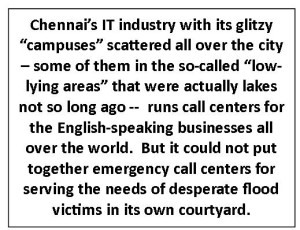
In this rain season, the first floors in the multi-story housing complexes built with government approval were flooded with 6 to even 10 feet of water. These people have lost their personal belongings and suffered heavy losses. Those occupying higher floors, even though did not suffer personal losses, would see their net worth reduced because of the drop in the market value of their apartments. Here are the samples of pictures of the Chennai Floods of 2015: http://tinyurl.com/Pics-ChennaiFloods .
Even if 200,000 apartments need to spend, say, only Rs. 200,000 per apartment for repairs , you are talking about Rs. 40,000,000,000, or Rs. 40 billion, or 4,000 crores in personal losses. Then they need to rebuild roads and other damaged infrastructure. Many thousands of poor people have lost their whole house built on the “regularized†lands along the river bed granted to them for free. There is no way any government can compensate for these people’s personal losses.
So, we cannot call it a “natural†disaster, any more than Katrina was a natural disaster. The 2015 Chennai rains is a severe natural event that became a man-made disaster by the reckless omissions, commissions and sins in urban planning, and in the management of urban growth, and tardiness in preparing for the monsoon by the elected governments. And this was made worse by the total lack of respect for the land, its terrains and its environs by every Chennai-vasi, both rich and the poor, educated and the uneducated, powerful and the weak. But the onus on the rich, educated and the powerful for this man-made disaster is far greater. Every Chennai-vasi – the anglicized would hate this rustic term, their preference is Chennaiites – has directly and indirectly contributed to this disaster.
But as it happens in India, nobody will be held accountable and nobody will own up responsibility for the man-made disaster. Those responsible will hide behind Climate Change and the Act of God.
This man-made disaster needs a drastic package of solutions requiring thousands and thousands of crores of rupees and long time frame to get to the root causes and then fix them. Some of these are: restoration of the natural ponds and lakes all along the coastal areas prone to puyals, cyclones and hurricanes; a plan in place for the periodic dredging of the estuaries of the three rivers in Chennai at the sea, and keeping water flowing in the rivers snaking around Chennai. These rivers are cesspools now; resettling the poor people living along the riverbeds and basins in safe places and giving them homes they completely lost; and keeping the river beds free from future encroachments. These are not easy.
Since every Chennai-vasi has directly and indirectly contributed to this disaster, every one of them also has to pay for it for fixing it, maybe through a 0.5% Floods Tax on their income and a small raise in sales tax. After all, they have been making their money out of Chennai’s growth.
This requires a major course correction in the lifestyles for the Tamil society as a whole, particularly among the educated Tamil established classes and its political and social elites since they are the trendsetters. Arasan evvazhi, avvazhi makkal, or Yatha raja, tatha praja. The Tamil society and the sizable non-Tamil residents of Chennai metro area need to understand and respect their own ecosystem and design a lifestyle around it, rather than transplanting a lifestyle that worked somewhere else faraway under different ecosystems. Whatever is true to Chennai is true for every other Indian metro area.
Long term, India has to evolve a policy to disperse its population in newer smaller cities all across the nation instead of making the existing metro areas grow and grow, till they simply collapse, as Chennai did.
On media coverage, the Tamil print media did a far better job in getting the historical information on the regions’ water management policies over the last 800 to 1000 years by going to original sources in the Tamil language. Here are the examples:
1. tinyurl.com/Dinamani-MaraVendumManobhavam by N Gurusami
2. tinyurl.com/varumum-kAvathAn by R. Rajagopalan
3. tinyurl.com/katrukkolla-maRukkiROm by Mr. K. Pazhanitthurai
The titles of the articles in translation tell everything about its contents: The Mindset Has to Change; The Life of the Person Who Never Prepares; and We Refuse to Learn.
The English print media (The Hindu and others) did a pretty bad job on this point. This is understandable. Both its anglicized writers and semi-anglicized urban readers are completely cut off from their own hinterland linguistically, culturally, and ecologically. END
A Remarkable Story on Compassion & Caring
Posted by admin in January 2016 on December 28, 2015
By Krishnaa Raman, Savannah, GA
e-mail: araman83@aol.com
Recently, I was in Kochi, India, to be with my only sibling, my sister Meena, to mourn the passing of my mother. One of my uncles happened to be visiting from Delhi, and he performed the cremation rites and the ceremony of mixing the ashes with the waters of the Arabian Sea. According to tradition, women cannot perform the subsequent eleven days of the last rites for the departed, and so my sister and I decided that we would feed the poor and destitute on three days. We also felt that Amma would be very happy with our decision!
My sister talked to one of her friends who suggested going to this building where Murugan, an auto rickshaw driver, takes care of about thirty people. We got to his place at 11:30 am and arranged with a caterer to bring lunch around noon time. This young man of thirty-two, Murugan, has photos of getting recognition from the President of India, Sri Sri Ravi Shankar and other notable people; laminated copies of all the articles written about the work he has done were on the wall.
I asked him how he got involved in this work of rescuing street children and the really poor, destitute people on the streets.
“I had spent ten years in an orphanage, because my father was an alcoholic. Brother Mavooris, a well-known social worker in Kochi, gave me a new lease on life at Don Bosco Snehabhavan, taught me to speak and write in Malayalam, and helped me complete my high school education in the open school system.Â
“I then decided that I am going to help children who were wandering in the streets. I did not want to ask for donation. So, I learnt to drive an autorickshaw for funds to support this cause. So far, I’ve rescued over 2,000 children.
“I have developed a procedure for this to get support. I inform the police when I see a child on the streets before taking them to the orphanages where I feel they will be safe and also get an education. I also follow up on their care.â€
“How do you end up taking care of adults too?†I asked.
“In the last few years, I saw older people on the street abandoned. I started picking them up; many are mentally ill and physically sick. I get the police involved, give them a bath, take them to a hospital where the doctors who I personally know, and who know my work, can check them out and give them proper treatment. They give these people medicines. I transport them for court appearances if needed, and then find an institution to take care of them. Some of them now live in a building that the city has donated to me.
“I have a few goats for milk, some chickens for eggs, and a vegetable garden. I recently received ambulances donated by a large petroleum company. In spite of the publicity I’ve received from the press and television, I am often short of funds for the care of these abandoned people. The problem is so huge.â€
I was awe-struck to see what Murugan has accomplished at his young age! How does an eighteen-year-old know what his life’s purpose is? Then how does he focus in on working towards that goal with his own situation so precarious?
Murugan told me he does not ask anyone for funds, but manages with whatever he gets. Evenings are spent driving his auto rickshaw, so he can support his wife and his new-born baby and get the funds required for “his people.â€
His daytime is devoted to his social work, taking care of the people no one wants. I consider it a blessing that I got to meet Murugan, someone extraordinary. Meeting Murugan has renewed my faith in humanity.
To know more about the details and challenges of Murugan’s work, go to www.theruvoram.org.
Youthful India
Posted by admin in January 2016 on December 28, 2015
Premlata Venkataraman
For decades, I recall from my younger days, India’s thinkers and rulers described its population as a problem in political discourse. But these days, India’s Prime Minister Modi frequently boasts on the global stage that India is filled with youthful energy, with 30% of its 1.25 billion people between the ages of 6 and 30 years. He is deftly turning the tables on looking at India’s younger population as an opportunity, if only we know how to harness it.
During a recent visit to India, this heady exuberance was staring at me wherever I went. It was no idle boast. Living in Pittsburgh with an aging population — Pennsylvania is one of the most geriatric states in the union — we have become accustomed to see aging people running airports, shopping malls, grocery stores, and a slower pace of life.
In direct contrast, just landing in India brings one face to face with the energetic bustle of India’s youth.Even arriving at the sparkling new airports in Kochi, Bengaluru, Hyderabad, Mumbai or New Delhi, you see everywhere young employees in slick uniforms striding along briskly, ready to solve passengers’ problems. If one feels a little gray and tired in the face of this energy, rest assured, it is not just the long journey, but India’s bubbling youth staring at you.
Of course, as India’s youth seek the holy grail of success, what they need is quality education and skills allowing them to compete locally and globally. Doors are literally opening for educated, skilled, and qualified Indians all over the world. In the changed atmosphere in India today, even IITs have opened more campuses. Engineering colleges, especially those in information technology and computer science, have chaotically sprouted up throughout the land to meet the demand. Indian youth is so attuned to opportunities that if there is a slight drop in demand in certain fields, the enrollments in colleges in those disciplines drops drastically, much to the chagrin of the new colleges without reputation.
Needless to say, for young people, having the right multinational employer and an upwardly mobile career give a lot of disposable money. India’s new consumer economy is looking precisely for this demographic slice to grow and prosper. It is no surprise that there is a mall in every suburb, selling the most upscale designer merchandise, and bars and food joints all around.
Young people with more money than their parents and grandparents had accumulated over their lifetime live a lifestyle that is quite alien to the elders. Eating out at fancy eateries, dressing in the most fashionable clothes and driving high-end foreign automobiles have become quite de rigueur. Throw in also weekend jaunts to Sri Lanka, Thailand, Singapore, and Dubai for singles…
At the fancy new airports in India, you find affluent young parents with children in tow going on vacation to the choice spots of the world. Not long ago, flying in India was for the wealthy and businessmen; for others, it was usually only for family emergencies.
But the picture is not all rosy for the new Young India. If manufacturing and service sectors are not able to provide jobs for teeming millions, they will hit turbulence. Countries having a lot of young people who don’t have jobs encounter social unrest. Look at Greece and Spain.
If India is to avoid this, its federal and state governments and its burgeoning businesses need to grow at a pace fast enough to absorb its young with jobs. For this to happen, its manufacturing and service sectors have to further expand, for which a good infrastructure is necessary.
As long as every segment of India feels that it is getting a slice of the pie, there will be economic mobility and hence social stability.   ♦
Duquesne University School of Law Hosts “Gandhi: The Lawyerâ€
Posted by admin in January 2016 on December 28, 2015
By Meghan Collins
Duquesne Law Student and Juris Editor-in-Chief
Note: Shankar Rao Dittakavi, a long-time resident of this area and a well-wisher of the Patrika from its very first issue, is Associate Director at the Duquesne University Center for Legal Information and Allegheny County Law Library. He informed us of this program.
On Thursday, November 5, 2015, Duquesne University School of Law presented an insightful program exploring Mahatma Gandhi’s young life as an attorney in India and South Africa and how the years impacted his future as an international human rights leader.
Dean Ken Gormley organized “Gandhi: The Lawyer†and moderated the panel discussion with two Gandhi scholars: Rajmohan Gandhi and Charles R. DiSalvo.
Rajmohan Gandhi is the grandson of Mahatma Gandhi and a well-known author, scholar and humanitarian. In his career, he has written extensively on South Asian history with a special focus on dialogue and reconciliation between divided communities, including between Hindus and Muslims in South Asia.
Charles R. DiSalvo is the award-winning author of M.K. Gandhi, Attorney at Law: The Man before the Mahatma (Berkeley: University of California Press, 2013). He holds the Woodrow A. Potesta Professorship at the West Virginia University College of Law, where he teaches on civil disobedience.
Mahatma Gandhi, as most people know, was one of the greatest figures of peace in the 20th century. Yet many people do not know that Gandhi was formally trained as an attorney. It was during his time in London that he began to find his calling as a civil leader for the people of India.
The panelists introduced interesting insights into Gandhi’s journey and who he was as a man rather than solely as a political figure.
Gormley asked why Gandhi’s transformative experience of getting forcibly kicked out of a first-class train car in South Africa because he was not white was so significant.
Charles DiSalvo discussed that it was this moment coupled with a courtroom incident, where Gandhi was told to remove his turban, which inspired Gandhi to do something about the way Indians were treated.
“In South Africa, when he found his purpose, he found his voice,†said Rajmohan.
Rajmohan said of Gandhi, “His genius was finding a way to involve millions of people while pointing out the absurdity of British rule.â€
Gormley ended the discussion by asking how Gandhi’s training as a lawyer and his experiences as a lawyer helped shape the person he was, and ultimately what his legacy is.
Charles DiSalvo commented that “The most important thing [that he took from being a lawyer] was that he was turned into a public person; he learned to think, speak, and act in public. He could speak to crowds of thousands of people for hours without notes.†Ultimately, Gandhi’s legacy, says DiSalvo is “whether the work we are doing reaches our deepest moral and political values.â€
Rajmohan said that Gandhi taught us to “[live] for something much more than for ourselves.â€
Duquesne University presented “Gandhi: The Lawyer†in association with the Pittsburgh Cultural Trust’s India in Focus cultural showcase.  Â
The Pittsburgh Patrika’s Twenty Years
Posted by admin in January 2016 on December 28, 2015
By Premlata Venkataraman

With the October 2015 issue, The Pittsburgh Patrika crossed a milestone. It was 20 years ago in October 1995 that we mailed our very first issue of the magazine. It was a nebulous idea coming true for my husband Kollengode S. Venkataraman, who is a news junkie by habit, an aficionado of Tamil classics, a dabbler in eclectic things here and there, a man with opinions on many facets of life, and willing to put them on paper. Incidentally, maybe accidentally, he is an engineer by profession.
When he bounced around the idea of a magazine for the Indian diaspora, most of the advice he got was that there would be only minimal interest. Since most of the activities then, and still now, occur at religious centers with their own newsletters, there really was nothing else to cover. With our two daughters still in school and the huge cost of their college education staring at us, we set out to give the venture a try, mentally ready for the magazine’s neonatal death.
In the first issue, Venkat wrote, “This newsletter is a forum for airing and sharing your views, ideas, even frustrations, on any matter of topical and not-so-topical interest. [We, the Indians here] have quite a diversified background, and yet are so very alike. When we look through our patina of sophistication, we often see that our pleasures and pains, anxieties, concerns, hopes, expectations, even griefs, are similar. The Patrika’s intention is to entertain and inform people who share a certain value system, and are curious about what is going on in our midst… … If you feel strongly on any matter…, now you have a forum to air it.â€
The first issue (with no advertisements,) only talked about the intent of what the future issues would cover. Vividly we remember now: we did not want to staple the magazine on its spine since that would involve an additional $8 for the 400 copies!
Early on, we decided the focus would be on our Indian and American experiences relating to our lives in Western PA, something neither fully Indian, nor presumptuously American, to echo the evolving identities of Indian immigrants who now call Western PA their home. The name Pittsburgh Patrika truly reflected our pan-Indian and yet American identity in Western Pennsylvania, in which Pittsburgh has a dominant presence.
On these points, your magazine, all through these twenty years, has stayed true to what it set out to do. We do cover stories/trends/political upheavals that occur in India and here as well, but always keeping the focus on how it relates to our lives here.
While covering the events put together by the Desi Diaspora here, we are astounded at the vibrancy of the talented people pursuing different facets of our culture. Whether it is Holi, Garba, Pongal, Diwali, India Day, or Gandhi Jayanti, we are ready to gather and party! Covering these events and getting to know the organizers has been a lot of fun.
When we started, our understanding was that we attended our temples, went to our weekend parties, liked cultural programs, and were always preoccupied with our children’s discipline and education. But we were astonished by the treasure trove of hidden talents in the community and were enthusiastic to highlight the best of India and integrate it into the American mainstream: music teachers and talented dance teachers and their students, artists, painters, henna artistes, social activists, fundraisers for local causes, volunteers in mainstream organizations. Highlighting these activities has been the most satisfying part of running the magazine. We must here acknowledge the conducive atmosphere of multiculturalism encouraged in the US.
In recent years there has been a trend for fundraising for many local causes by Indian-Americans here. Staging music and dance shows or even organizing 5-K walkathons to help those less fortunate in our neighborhood is a very healthy, welcome trend. Giving greater visibility to these events in the magazine, we hope, ensures more participation.
Personally it has been an educational and humbling experience for us in this small undertaking. While researching stories and interacting with people coming from different parts of India, we realize how much more we all have in common. With more and more of our youngsters intermarrying among ourselves and with mainstream Americans, we will come together as a single community uniting under the banner of our Indian-American identity, even as we integrate rapidly into the American mainstream.
Another point is that articles in The Patrika are authored by people living right here among us. This makes the magazine interesting reading. We thank these writers for their interest. We acaknowledge our reader’s kind words they tell when we meet them in social gatherings.
Many young people who have “grown up†reading The Patrika still visit us on Facebook and the web page. It is gratifying when you tell us how eagerly you look forward to the next issue and how you read it through in one sitting. And we cherish articles writen by some of these youngsters. So thank you for your interest.
Publishing this magazine in our spare time was a challenge with sporadic work-related domestic and overseas travel. Also, we neither seek nor get any grants from governmental, social, cultural, religious organizations, or corporate or charitable foundations. We believe that in the Free Market environment, any activity has a reason to exist only if it is able to at least pay all the bills on its own. Depending on grant money often saps the vitality of organizations, especially, magazines.
Our only source of revenue for meeting the ever-increasing cost of printing and mailing the magazine to nearly 2000 homes every quarter is advertisements. So, we owe our very existence to our advertisers for their support and confidence in our integrity.
We profusely thank our advertisers and look forward to serving you and our readers better in the years ahead. We also thank a handful of well-wishers who, on and off, on their own and out of goodwill, send us voluntary contributions in support. ♦


